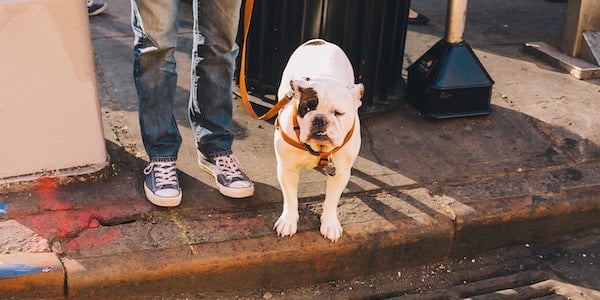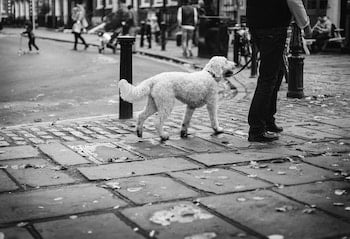
Imagine walking with your dog around town and coming up to a crosswalk at a busy intersection. Your dog sits automatically with no verbal cue or prompting from you when you stop at the curb — not only do you and your pup look like obedience rockstars, but your dog is safe since they aren’t walking straight out into traffic.
Now imagine you encounter a friend while on your walk around town. Instead of rushing up to them and jumping, your dog sits politely at your side and waits while you two humans stop and chat. This can be your reality with some easy and consistent training!
What is an Automatic Sit in Dog Training?
An Automatic Sit (also called the Auto-Sit) is when your dog sits automatically at your side when you stop walking with no verbal cue and stays until they are released to move forward again. This is an intermediate training cue, and while it might seem complicated, if your dog has the required prerequisite skills, it just takes practice and consistency for your dog to learn this behavior.
Prerequisites to Starting to Teach the Automatic Sit
Before you start working on an Auto-Sit, you and your dog need to already have a solid Sit-Stay using just a hand signal, experience with using a release cue, and polite leash walking skills.
If your pup doesn't know Sit-Stay yet, check out this video for some great basic training tips:
This video shows how to teach a release cue after your dog knows how to sit:
If you're not sure your dog knows the hand signal for Sit, watch this video about how to teach your dog hand signals — you might already be using a hand signal without realizing it! Most hand signals are smaller versions of the lure used to teach a dog to Sit in the first place. There is no verbal cue for this Automatic Sit behavior; your dog learns that the cue to sit automatically is when you stop walking.
Pro Tip: Consistency is key to teaching your dog the Auto-Sit. Any time you are out walking your dog on leash and you stop walking forward, the behavior needs to happen before you can continue on. If you don’t do this, your dog will have a tough time knowing when they’re expected to sit and when they’re not, and you will never have a reliable Automatic Sit.
Training Tools You’ll Need:
-
High-value training treats, pea-sized or smaller
-
Your treat pouch to keep treats easily accessible while on walks
- Your clicker or a marker word (such as "yes!")
How to Train the Auto-Sit in 5 Easy Steps
- Go for a walk: Take your dog out for a leashed walk. Whenever you stop walking, give your dog your hand signal to Sit. Do not say any verbal cue.
- Treat at the right time: When they Sit, click (or say your marker word), give them a treat and praise.
- Say the release cue: Before you start to walk forward, say their release cue (All Done, Okay, Freedom, etc). This makes it clear to your dog that it’s okay to move out of the Sit position and walk forward again.
Make sure you always give your dog permission to move again by using your release cue, otherwise your dog might get up whenever they feel like it or get distracted. If they get up before you've released them, go back to practicing your Sit-Stays in easier environments before increasing the distraction level. - Repeat, repeat, repeat: As you practice, you should see your dog start to anticipate and offer a Sit after you’ve stopped walking, but before you give the hand signal. They’ve learned that you stopping precedes the hand signal, which precedes the Sit behavior (which precedes the treat!) This is called "cue transference." When they’ve learned this, it means you shouldn’t need the hand signal anymore unless your dog is too distracted and needs a little jump start. Great job at being consistent!
- Phase-out treats: After your dog has transferred the cue, you can start phasing out their training treats (and clicker if you've been using one). Check out this article for in-depth instructions on how to fade out the use of treats while training your dog.
 Troubleshooting the Auto-Sit Behavior
Troubleshooting the Auto-Sit Behavior
- I’ll say it again for those in the back: Consistency is key for this cue. Any time you stop walking, your dog must Sit before you can move forward again.
- If they don’t sit with a hand signal, you might need to take a step back and address their Sit behavior separately before training the Auto-Sit. This might mean using a treat in your luring hand rather than a regular hand signal with no treat.
- You can practice this behavior at different times and places other than your regular leashed walk. It’s a great behavior to teach your puppy when greeting people on or off-leash!
Watch This Training in Action:
Here are some examples of practicing the Auto-Sit while on leash:
In this video, you'll see the puppies learning that Auto-Sit gets them attention and treats when they greet someone while off-leash:
Try out the automatic sit training steps above and let us know how your dog is progressing!




